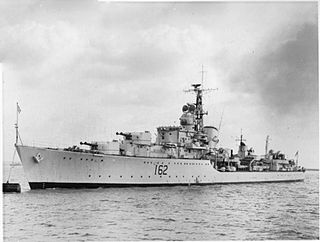Related Research Articles
At least five ships and one shore establishment of the Royal Navy have been named HMS Warrior:
Five ships of the Royal Navy have been called HMS Agincourt, named after the Battle of Agincourt of 1415, and construction of another was started but not completed.
Six ships of the Royal Navy have been named HMS Indefatigable:
Eight ships of the Royal Navy have been named HMS Ardent, whilst another two were planned:
Six ships of the Royal Navy have been named HMS Edinburgh, for the Scottish city of Edinburgh. In addition, one ship of the Royal Navy has carried the similar name HMS Duke of Edinburgh.
Nine ships of the Royal Navy have been named HMS Grafton, while another one was planned:
Several ships of the Royal Navy have been named HMS Liberty.
Six Royal Navy ships have borne the name HMS Southampton. All were named after Southampton, a port on the south coast of England.

HMS Jutland (D62) was a later or 1943 Battle-class fleet destroyer of the United Kingdom's Royal Navy. She was named after the Battle of Jutland, the largest naval battle of the First World War. The first Jutland was launched in 1945, but was cancelled that same year. Her sister ship, Malplaquet - named after a battle between Britain and France during the War of the Spanish Succession in 1709 - was renamed Jutland just prior to her launch on 20 February 1946, and was commissioned on 30 July 1947. The original Jutland was finally broken up in 1957 at Rosyth.

HMS Dunkirk (D09) was a later or 1943 Battle-class fleet destroyer of the British Royal Navy (RN). Though there were other ships of the Navy that had been named Dunkirk, as far back as the 1650s, it held added meaning after the evacuation from Dunkirk between late May and early June 1940, in which over 300,000 British, as well as French troops, were rescued by a ragtag fleet of ships.
Several ships of the British Royal Navy have been named HMS Bruiser or HMS Bruizer.
Many ships of the Royal Navy have been named HMS Garland. The name dates back to 1242, being the oldest confirmed ship name in the Royal Navy.
Twelve ships of the Royal Navy have been named HMS Active or HMS Actif, with a thirteenth announced:
Thirteen ships of the Royal Navy have been named HMS Shark after the shark:
Nine ships of the Royal Navy have been named Mary Rose. The first is thought to have been named after Mary Tudor, sister of King Henry VIII of England, and the rose, the symbol of the Tudor dynasty. Later Mary Roses are named after the first.
Three ships of the Royal Navy have borne the name HMS Acasta, whilst another two were planned:
Three ships of the Royal Navy have been named HMS Onslow:
Eight ships of the Royal Navy have borne the name HMS Defender:
Three ships of the Royal Navy have borne the name HMS Nestor, after Nestor, a figure in Greek mythology:
There have been two ships of the Royal Navy named HMS Rosalind, named after the protagonist in William Shakespeare's As You Like It:
References
- Colledge, J. J.; Warlow, Ben (2006) [1969]. Ships of the Royal Navy: The Complete Record of all Fighting Ships of the Royal Navy (Rev. ed.). London: Chatham Publishing. ISBN 978-1-86176-281-8.